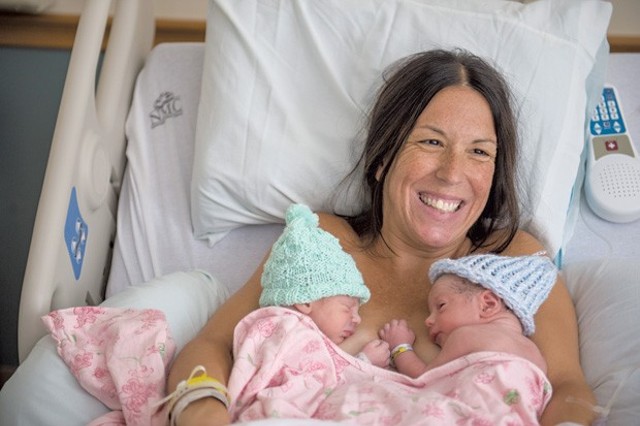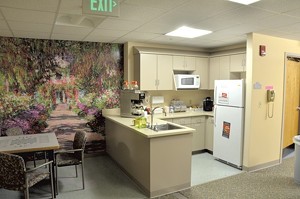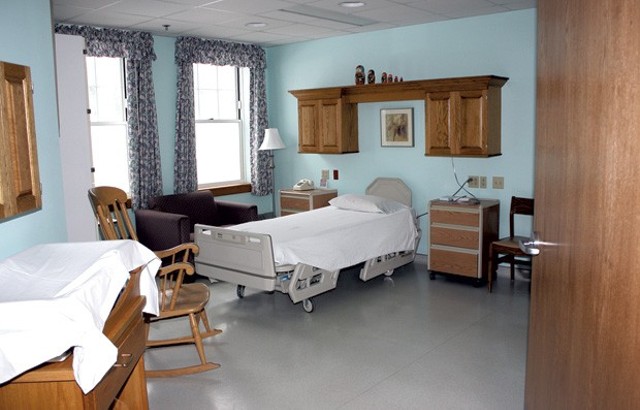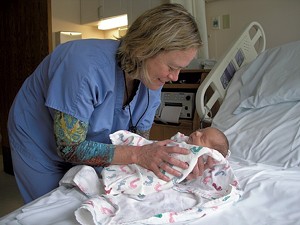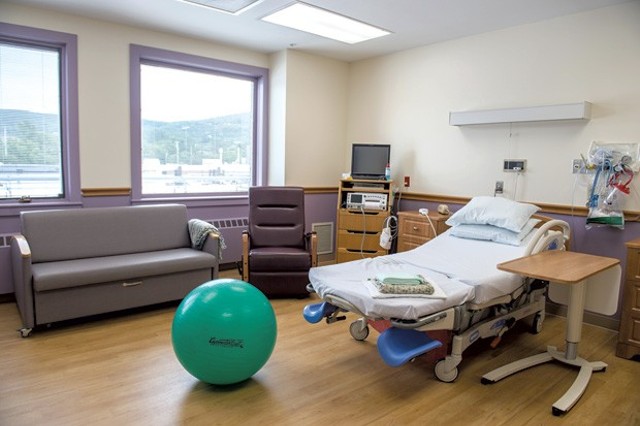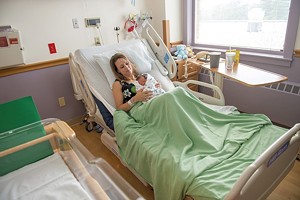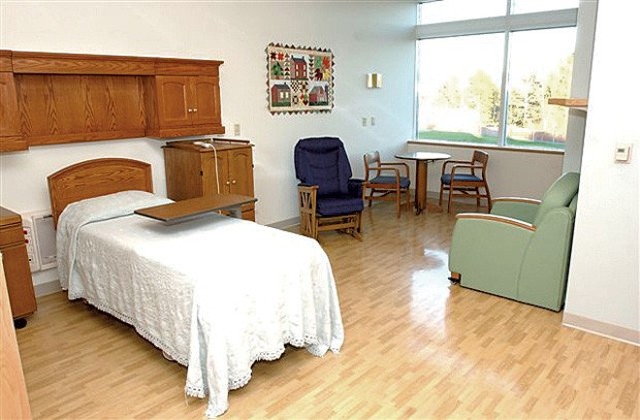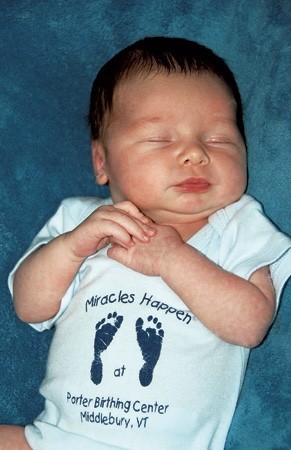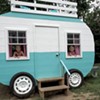Published April 29, 2014 at 12:30 p.m.
Choosing where to deliver your baby is unlike any other medical decision. Break your arm and you'll likely end up in the closest emergency room. Women expecting new babies can start browsing their options months in advance.
Some Vermont women — about 2 percent — deliver at home; the state has one of the highest rates of home births in the country. Still, the vast majority of moms-to-be in the 802 deliver in a hospital birthing center, and Vermont's are not all the same. A facility with a homey, community vibe won't likely have a neonatal intensive care unit down the hall. A pregnant patient might have to give up her water-birth dream for the luxury of staying in one room for the duration of her stay.
I visited six Vermont hospital birthing centers in the Kids VT circulation area to find out what makes each one unique. I had never before set foot in a labor-and-delivery unit, but I brought an important perspective: I was eight months pregnant. With each visit, I tried to imagine myself waddling in on the big day.
All of these hospitals offer similar services: pharmaceutical pain relief in the form of epidurals and intrathecals; the chance to deliver a baby vaginally after a previous cesarean section, aka VBAC; an in-hospital, Wi-Fi connection to post updates to Facebook. All of them encourage skin-to-skin bonding after delivery.
The biggest difference I found was between the five community hospitals I visited and Fletcher Allen Health Care, a major tertiary care hospital. At the community hospitals you can stay in one labor-and-delivery-postpartum room, aka LDPR, from check in to check out. Post-delivery at Fletcher Allen, all new moms are moved to a separate maternity floor.
On the upside, Fletcher Allen has the state's only neonatal intensive care unit; the next closest NICU is at Dartmouth-Hitchcock Medical Center in Lebanon, N.H. If complications arise during deliveries at any of the smaller facilities, a team from Fletcher Allen brings the babies to Burlington.
I found something to like about each birthing center and would feel comfortable delivering at any of them. Read on to find out why.
Central Vermont Medical Center, Berlin
Births per year: 420
C-section rate: 31%
Water births: no
The first things I noticed at Central Vermont Medical Center's Garden Path Birthing Center were the colorful belly casts adorning the walls. Pregnant ladies made these replicas of their voluptuous torsos with on-staff lactation consultants.
Those looming bellies and boobs set a holistic tone at CVMC, which otherwise feels very much like a hospital, with fluorescent lights, cream-colored walls and the smell of disinfectant in the air.
Renovated in 2008, the Garden Path Birthing Center has six LDPRs, each with a TV, a tub for laboring and a fold-out sleep chair for one support person. An operating room is located on the same floor, in case a C-section is required.
Nurse manager Kathy Pelletier pointed out that the rooms, built with the same soundproof sheetrock found in movie theaters, are relatively quiet. And she was right. It wasn't until we stepped out into the hall that we heard wild screaming emanating from another room.
Community outreach is an important part of CVMC's birth center, which hosts open houses once a month and a variety of support groups, including ones for new dads and for parents who have lost a child.
The nurses collectively crafted a written birth philosophy, which hangs framed near the front desk: "A woman's body is designed to give birth. Her inner wisdom will lead her. Every birth is unique. We support and accompany each woman along the birth journey while protecting her emotional security, safety and sense of privacy. Celebrating with a birthing woman and her family is the highest honor."
Food: The community kitchen is more than just a kitchenette; it's a comfy corner space enlivened by a colorful mural. A table with chairs accommodates groups. Throughout their stay, both mom and partner can order room service, which is available from 6 a.m. to 6:15 p.m.
Other perks: CVMC has two doulas on staff. They work with laboring women to find comfortable new positions and to alleviate pain naturally. The hospital also offers pre- and postnatal yoga classes.
Copley Hospital, Morrisville
Births per year: 250
C-section rate: 19%
Water births: yes
Copley's birthing center, which opened in the mid-'80s, has an undeniable Earth Mother vibe. Only midwives deliver here, except in the case of twins or if the mom has been transferred to the hospital during an attempted home birth. That might account for its C-section rate, which is the lowest among the birthing centers I visited.
Homemade quilts adorn the beds, and the four LDPR rooms are each painted a different color to represent the natural elements: earth, wind, water and fire.
Three of those rooms have TVs and attached bathrooms with showers; one has a deep tub, which the nurses try to keep available for all laboring moms. About 80 to 90 percent of women use the tub at some point, nurse midwife Jackie Bromley told me. "I think of it as one of our many pain-relief tools," she said.
The midwives pride themselves on exploring more holistic pain-relief options first, but they also offer pharmaceutical relief, such as spinals and epidurals. If a C-section is needed, the OR is just down the hall on the same floor.
Copley isn't the kind of hospital where a woman sees her provider occasionally throughout her labor. The midwives here make an effort to spend time just sitting in the room with the mom-to-be, keeping an eye on her progression.
"It's very calming," says nurse manager Steffany Mosley. "It provides a sense of empowerment for the mom."
The visiting policy is flexible, primarily to make it easier for families who already have children at home. Kids are allowed to visit, and even stay over, if they need to. Copley also offers parents the option to leave soon after the birth, if baby and mom are healthy. "We try to be really flexible with what families want to do," said Bromley.
Food: Each room has a mini-fridge. A kitchenette has staples such as cereal, yogurt and juice. Moms get three meals delivered to them between 7:30 a.m. and 5 p.m. Copley's head chef used to work at Topnotch Resort in Stowe, so the menu includes gourmet flourishes.
Other perks: On their last night in the hospital, families can order an extra-special, three-course dinner. Hospital staff set up a table — with a tablecloth! — in their room and supply a bottle of sparkling grape juice to sip with the celebratory meal. They go home the next day with a complimentary baby blanket.
Fletcher Allen Health Care, Burlington
Births per year: 2000
C-section rate: 25%
Water births: yes
As Vermont's only teaching hospital, Fletcher Allen Health Care has a high-energy vibe. I walked in on a midweek morning to hallways swarming with people. Finding my way to the labor-and-delivery floor was a bit complicated; Fletcher Allen has two different elevator systems that only reach certain parts of the hospital. It's a long walk from the parking garage to the McClure elevators, which take you to the birthing center on the seventh floor.
Oh, and watch where you're going; I was nearly mowed down by a gurney I didn't see careening around a tight corner. Still, I liked the sense of excitement.
The Claire M. Lintilhac Birthing Center opened in 2004. It has seven labor-and-delivery rooms, three in-patient rooms, two operating rooms (big enough to accommodate triplets) and a couple of triage rooms. If it's really busy, an ultrasound bay can be used for delivery.
The state's only neonatal intensive care unit is located just down the hall, and there's also a maternal-fetal medicine unit for high-risk pregnancies.
Fletcher Allen definitely feels — and smells — like a hospital; you won't find medical equipment tucked away in cubbies or behind landscape paintings here, as you will at many of the community hospitals. But the rooms are nonetheless clean, sunny and welcoming.
Room 4, with its freestanding tub, is designated for water births, but all the labor-and-delivery rooms have tubs deep enough for women to deliver underwater. One ADA-approved room has a walk-in shower.
The unit's figure-8 layout lets moms-to-be stroll the halls while laboring; 18 times around is a mile.
"We really encourage people to get out of their rooms and walk around," says nurse manager Mary Clairmont.
Two hours after birth, new families are transferred down two flights to the mother-baby floor, which is dimly lit and somewhat cavelike, especially in comparison to the shimmering birthing center. The good news? Fletcher Allen is building a brand-new maternity unit in 2015.
Food: On-demand room service from the Harvest Café's locavore chefs is available from 6 a.m. to 7:15 p.m. A kitchenette is stocked with staples such as juice, Popsicles, peanut butter, bread, chicken soup, crackers, and mac and cheese.
Other perks: Moms may be too focused on labor to notice, but their support people will likely appreciate the stunning views of Burlington and Lake Champlain, especially from the spacious Labor Lounge, which is decked out with rocking chairs and other comfy seating.
Gifford Medical Center, Randolph
Births per year: 300
C-section rate: 24%
Water births: yes
In 1977, Gifford Medical Center created Vermont's first hospital birthing center, a space designed to allow moms and babies to stay in one room together throughout the childbirth process. It was the result of a collaboration between family practitioner Thurmond Knight, who performed home births in the area, and Gifford pediatrician Lou DiNicola.
"The story goes, they were all at a medical staff meeting," explained communications specialist Robin Palmer. "Thurmond Knight was knitting in his Birkenstocks, and Lou said to Thurmond, 'What would it take for you to deliver babies at the hospital?' And Thurmond said, 'A real birthing center.'"
Gifford now has five LDPR birthing suites — all have bathrooms with a shower; one has a deep tub for laboring and water births. There's a fold-out bed in each room, and nurses have been known to bring in an extra cot for additional support people.
The rooms — with floral curtains, rocking chairs, wooden cabinets and boomboxes —have a homey, almost grandmotherly, feel. Still, they're equipped for emergencies: Oxygen, suction and other medical equipment is stored out of sight in the cabinets. And the operating suites are located down the hall in the main hospital.
"When mothers come in, they can choose the room they want," said nurse Ellen Fox. "They get to set the thermostat. Some parents take down our artwork, hang their own. Some bring lighting. It's really their own environment from the moment they check in until they leave."
Food: A kitchenette always has a few pre-made sandwiches. Breakfast is delivered at 8 a.m. Lunch and dinner are made to order until 5:30 p.m. Gifford's head chef, who incorporates local, sustainable ingredients into the menu, was once a New England Culinary Institute instructor. Another chef, who trained at Le Cordon Bleu, makes a plate of homemade chocolate truffles for each new mom. They're sent to the room after delivery.
Other perks: Every new baby gets a hand-knitted hat. A lactation consultant and childbirth educator offer a free weekly New Parent Support Group.
New moms are likely to get a visit from Major McLaughlin, a 96-year-old former Marine who has volunteered at Gifford for 45 years. He drops by to talk to patients seven days a week.
When I saw him scooting along with his walker, he was wearing a button that said "free hugs." After a great hug and a brief chat, he hit me with his signature line: "Has anyone told you they love you today?"
Northwestern Medical Center, St. Albans
Births per year: 430
C-section rate: 30%
Water births: no
Northwestern's Family Birth Center, which opened in 1990, was one of the least hospital-y of all the places I visited. On a quiet Monday afternoon, my tour began in a spacious meeting room filled with gliders and comfy sofas.
NMC is especially committed to encouraging breast-feeding and skin-to-skin contact in the two hours immediately after birth, said clinical educator Stephanie O'Brien. "It needs to be uninterrupted," she said. On mom's bare chest, "Baby's vital signs will stabilize. Moms will feel less pain if baby's on them and release more oxytocin, the happy drug. It's the most optimal time. So we honor that."
NMC has four LDPR rooms. If a C-section is needed, the operating room is an elevator ride away, one floor down.
The LDPR rooms are big, with plenty of natural light, wood floors and purple walls. Each one comes with a convertible sleep chair for the support person.
NMC doesn't do water births but does have one separate room with a labor tub — and an iPod dock for setting the mood. All rooms have showers equipped with seats and hand-held nozzles. I tried out the bathroom and discovered it smelled pleasingly of berries.
Food: Room service runs from 6 a.m. to 6 p.m. The birth center has a kitchenette stocked with crackers, soup, Popsicles and ice cream. The biggest selling point, if you ask this pregnant lady: "We can make milkshakes," O'Brien told me. "We have a blender."
Other perks: Each baby goes home with a hand-knitted hat and a sleep sack. The hospital recently launched a new prenatal program called Healthy Beginnings, which is based on a model of group care called Centering Pregnancy. Instead of each pregnant woman seeing her doctor or midwife individually, a cohort of women (at the same stage in their pregnancies) sees one provider as a group.
"It's a more efficient use of the provider's time and builds in support for the patients," said O'Brien. She noted that the program encourages women to take a more active role in their health care, since they weigh themselves and take their own blood pressure at each meeting.
"Some moms really don't have great support systems out there," O'Brien said. Being part of a group helps them to build lasting relationships with women going through similar life changes.
Porter Hospita, Middlebury
Births per year: 350
C-section rate: 21%
Water births: no
If you're one of those pregnant ladies who fears giving birth on the curb or in the hospital lobby because you couldn't get to your room in time, you'll love Porter.
There is ample parking at this small community hospital, and the birthing center is just a short walk from the main entrance. When I visited on a late March morning, the place smelled clean and fresh, like lavender, and was almost eerily quiet.
Porter's Birthing Center opened in 2007. The hospital had decided it was time to update its vintage 1970 maternity floor, on which women would be relocated four times during their stay. The renovated birthing center now features four spacious and sun-filled LDPR rooms.
The rooms are homey, with iPod docking stations, sleep chairs for support people and pastoral views. "We tried to make it as homelike as possible by hiding all the scary hospital stuff," says spokesman Ron Hallman. Open the wooden cabinets and you'll find medical equipment. That framed landscape print on the wall? It slides away to reveal the hookups for a radiant newborn warmer.
The two operating rooms are just down the hall, and there's a procedure room where doctors could perform a C-section if both ORs are in use.
A spacious waiting room with TVs and Wi-Fi is steps from the birthing center. Beyond that, you'll find a courtyard with a garden, perfect for springtime mamas craving an outdoor stroll.
Food: Room service from the hospital kitchen is available between 6 a.m. and 6 p.m. "But we never let anybody starve," says nurse Kaitlin Rheaume. Laboring moms and their support people have access to a kitchenette stocked with healthy snacks, such as crackers and cheese, soup and juice. And each room has a mini-fridge for leftovers.
Other perks: Porter Hospital was the first in Vermont to offer supported-care postpartum visits. "Mom comes back after about 48 hours with the baby, and they go over everything: weight, jaundice, breast-feeding," says chief nursing officer Lorraina Smith-Zuba. "You could be here a half hour or four hours."
This article was originally published in Seven Days' monthly parenting magazine, Kids VT.
More By This Author
Speaking of KidsVT - Features,
-

Mr. Fix-It: Marty Spaulding Works Behind the Scenes to Help Students Learn on Campus
Aug 24, 2021 -

Back to School During Delta: A Pediatrician With Young Children Offers a Road Map — and Survival Strategies
Aug 24, 2021 -

Can You Dig It? Make Your Own Worm Farm With These Simple Steps
Aug 24, 2021 -

How to Savor Vermont's Shortest, Sweetest Season
Jun 29, 2021 -

Good Citizens Rocked the At-Home Challenge
Apr 6, 2021 - More »
Comments
Comments are closed.
From 2014-2020, Seven Days allowed readers to comment on all stories posted on our website. While we've appreciated the suggestions and insights, right now Seven Days is prioritizing our core mission — producing high-quality, responsible local journalism — over moderating online debates between readers.
To criticize, correct or praise our reporting, please send us a letter to the editor or send us a tip. We’ll check it out and report the results.
Online comments may return when we have better tech tools for managing them. Thanks for reading.



































